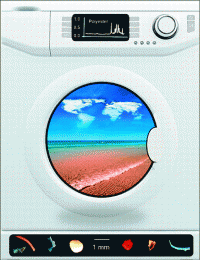Home washing machines: Source of potentially harmful ocean 'microplastic' pollution

Scientists are reporting that household washing machines seem to be a major source of so-called "microplastic" pollution -- bits of polyester and acrylic smaller than the head of a pin -- that they now have detected on ocean shorelines worldwide. Their report describing this potentially harmful material appears in Environmental Science & Technology journal.
Mark Browne and colleagues explain that the accumulation of microplastic debris in marine environments has raised health and safety concerns. The bits of plastic contain potentially harmful ingredients which go into the bodies of animals and could be transferred to people who consume fish. Ingested microplastic can transfer and persist into their cells for months. How big is the problem of microplastic contamination? Where are these materials coming from? To answer those questions, the scientists looked for microplastic contamination along 18 coasts around the world and did some detective work to track down a likely source of this contamination.
They found more microplastic on shores in densely populated areas, and identified an important source — wastewater from household washing machines. They point out that more than 1,900 fibers can rinse off of a single garment during a wash cycle, and these fibers look just like the microplastic debris on shorelines. The problem, they say, is likely to intensify in the future, and the report suggests solutions: "Designers of clothing and washing machines should consider the need to reduce the release of fibers into wastewater and research is needed to develop methods for removing microplastic from sewage."
More information: Accumulation of Microplastic on Shorelines Woldwide: Sources and Sinks, Environ. Sci. Technol., Article ASAP. DOI:10.1021/es201811s
Abstract
Plastic debris <1 mm (defined here as microplastic) is accumulating in marine habitats. Ingestion of microplastic provides a potential pathway for the transfer of pollutants, monomers, and plastic-additives to organisms with uncertain consequences for their health. Here, we show that microplastic contaminates the shorelines at 18 sites worldwide representing six continents from the poles to the equator, with more material in densely populated areas, but no clear relationship between the abundance of miocroplastics and the mean size-distribution of natural particulates. An important source of microplastic appears to be through sewage contaminated by fibers from washing clothes. Forensic evaluation of microplastic from sediments showed that the proportions of polyester and acrylic fibers used in clothing resembled those found in habitats that receive sewage-discharges and sewage-effluent itself. Experiments sampling wastewater from domestic washing machines demonstrated that a single garment can produce >1900 fibers per wash. This suggests that a large proportion of microplastic fibers found in the marine environment may be derived from sewage as a consequence of washing of clothes. As the human population grows and people use more synthetic textiles, contamination of habitats and animals by microplastic is likely to increase.
Provided by American Chemical Society



















